|
Choosing a Survival Knife
| Knife Sharpening
| Knife Steel Properties
| Knives and UK Law
| Knife Terminology
|
SIMPLES? REALLY?
There are so many different types of knives on the market that it's
understandable that lots of people end up totally confused and buy something that doesn't do what they were hoping it did.
You buy a Survival Knife because you may RELY on it one day for
your very life.
Whatever you do ... don't go for the cheap
option. That will probably let you down right at the moment when it counts.
If
you're serious about surviving in unforeseen situations then buy the
best you can afford because none of your money is any good to you if
you die as a result of choosing an unreliable cheap knife in the
local flea market!
WHAT TO CONSIDER
Now, a few very important things to consider before rushing
off to buy a Survival Knife:
- What is the purpose of the knife?
- What are going to be its main tasks?
- What will you trade off between corrosion resistance, edge retention, toughness and hardness?
- What sort of knife fits the bill?
- Can you afford it?
- Try to afford it ... or the next affordable compromise!
So, what is a Survival Knife expected to do? Here's a list of
tasks that any good Survival Knife should be able to accomplish:
- Extrication/Escape from being trapped
- Hunting
- As a spear
- Fashioning other weapons bows, arrows, stakes, etc.
- Making traps
- Up close and personal!
- Game preparation
- Gutting & cleaning
- Jointing
- Food preparation
- Wood processing
- Chopping
- Sawing
- Batoning/splitting
- Fashioning tools, etc.
- Whittling, carving & shaping
- Fire starting
- Feather stick making
- Creating a Bow Drill for fire making
- Creating tinder
- Shelter building
- Emergency stake or equipment hook
- Driven into ground
- Driven into a tree
- Area clearance
- Digging
- First aid
- Hammering & grinding
- Self defense
- Multi-purpose
Of course, that list is not exhaustive ... just what I think of
as important tasks. Now it's up to you to consider very carefully
what you need from the knife. Read through the pages to familiarise
yourself with knives before making your decision. I've tried throughout these knife pages to provide as much
information as I can think of to help you get the best tool to fit
your personal survival purpose. |
|
|
MIND MAP |
| There
are so many things to consider before finally
choosing the correct Survival Knife for yourself
that I thought I'd better put together a Mind Map to
help you (and me) understand all the areas that need
to be thought about. Imagine my surprise when I
developed this little monster below ... and I
can already see that there are areas that need still
more development! Don't let the apparent
complexity put you off though. If you click on the pic
it'll bring up a full size image in a new window (or
tab). Depending on which browser you're using you
may need to click on that image to bring it
up to full size. Feel free to print it out if you
want to. Once you've finished with it simply close
the window or tab to return here.
MIND MAP: CHOOSING A SURVIVAL KNIFE
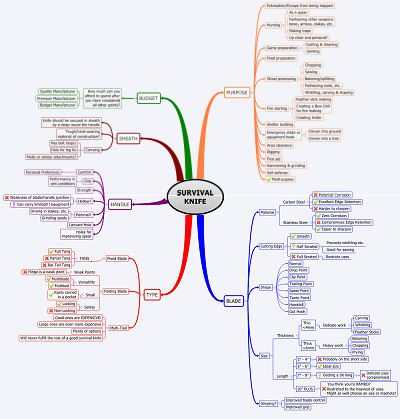
FULL SIZE = 1400 x 1467 px (332 kB) |
|

Of course, you can always pop over to
YouTube and look up Survival Knife reviews. They're often a lot
more helpful than the manufacturer's advertising blurb; but
please use them to confirm the detailed uses, strengths and
weaknesses of a knife AFTER you've decided on exactly what sort of
knife you need.
|
| If you want my opinion, for what it's worth, I'm not
going to guide you towards any particular knife. My own
preference is for a full tang, high carbon steel, spear
point, single edged with a good strong pommel and a blade of
around 5 - 6 inches (125 - 150 mm) which is in the region of
a quarter inch (5 - 6 mm) thick. Cutting edge with a scandi
grind and possible a secondary micro-ground edge (known as a
sabre grind). |
|
ANATOMY OF A KNIFE

You'll find a glossary of common knife terms on this website by
clicking HERE.
|
TANGS
The tang is the part of the knife you don't see much of. It's the
continuation of the blade steel back into the handle and it's
crucial to the overall strength of the knife. There are several
different types of tang, four being commonly found in fixed blade
knives: Full, Half, Partial, Rat-tail.
Full tangs make the strongest knives by far. The full tang
may even be extended out of the butt of the handle to give a
pronounced and very strong pommel.
Under heavy use, both the partial and rat tail tangs can bend or
break. Personally, I've had a couple of knives in the past where the
rat tail tang actually broke out through the handle - in one
case causing me a nasty injury to the palm of my hand.
|
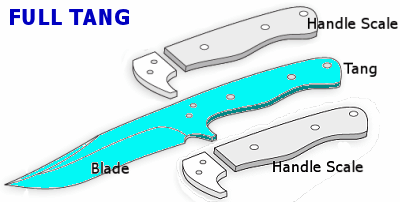 |
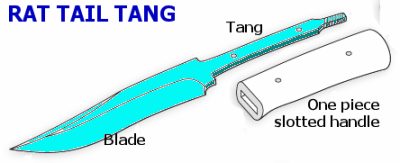 |
 |
GRINDS
Most quality knives start out life as a flat steel bar of uniform
thickness. The shape of the blade and tang is cut out and then it's
time to put an edge on it. This is usually achieved by grinding the
cheeks on each face at a specific angle to form a wedge shape, the
apex of which is the cutting edge.
Once again, there are several different types/shapes of grind as
well as grinds of different angles. Each has its own good and bad
points as to use and durability. Ask a dozen different knife experts
about the pros and cons of any particular grind and I guarantee
you'll get a dozen different answers. Each to his own! What I've
tried to do here is give you a straightforward description and the
most logical pros and cons.
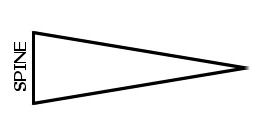 |
FLAT GRIND
The faces (or cheeks) of the blade are ground flat and
even from the spine to the edge.
 |
Easy to sharpen. |
 |
Cutting resistance is encountered the deeper the
cut when chopping/splitting wood, as the faces are
always in contact with the wood, increasing
frictional drag. Progressive sharpening changes the
angle at the edge or results in the blade
becoming progressively thinner. |
|
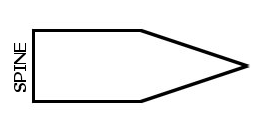 |
SCANDI GRIND
Like the flat grind, but starting some way down
the blade face
 |
Easier to sharpen than the flat grind, as you're
not removing nearly as much material. Better for
chopping and splitting. More robust edge. |
 |
|
|
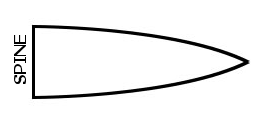 |
CONVEX GRIND
Sometimes known as the "Axe Grind" the faces are
ground curving in towards the edge. This grind may start at
the spine or some way down the face.
 |
Great at chopping and splitting, as it forces
the wood out and away from its main surfaces,
reducing frictional drag. Extremely durable. |
 |
Not much good for slicing or detailed work and
progressive sharpening results in the edge angle
becoming larger and larger, reducing its
effectiveness. |
|
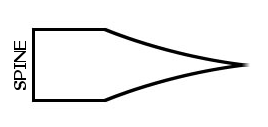 |
HOLLOW GRIND
The exact opposite of the Convex Grind. The ground surfaces
bow inwards (concave). Favoured by a lot of hunters.
 |
Produces an extremely sharp edge which is good
for dressing game. Great for fine work. |
 |
Edge is often so fine and contains so little
material that it is easily damaged. Not recommended
for chopping/splitting. More difficult to sharpen
correctly. |
|
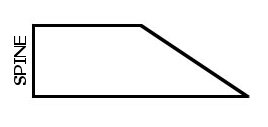 |
CHISEL GRIND
One side ground only, which gives rise to a very sharp
and sturdy edge, depending on the grind angle.
 |
Extremely sharp and very easy to sharpen.
Sharpening does not reduce its strength or diminish
its effectiveness. Ideal for carving, whittling and
food preparation. |
 |
The edge requires very frequent maintenance.
Most chisel grinds are ground on the right side,
which disadvantages left-handers. Not much good for
chopping or splitting. |
|
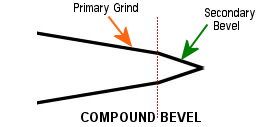 |
COMPOUND BEVEL
|
COMMON KNIFE BLADE SHAPES
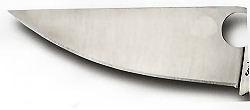 |
NORMAL
A normal blade has a curving cutting edge and straight back. A
dull back lets the wielder use fingers to concentrate force;
it also makes the knife heavy and strong for its size. The
curve concentrates force on a smaller area, making cutting
easier. This knife can chop as well as pick and slice. This
is also the best single-edged blade shape for thrusting, as
the edge cuts a swath that the entire width of the knife can
pass through without the spine having to push aside any
material on its path, as a drop-point knife would. |
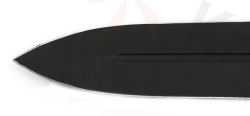 |
SPEAR POINT
A spear point blade
is one that is symmetrical
from tip to bottom and is essentially shaped like a
dagger. The main difference between a spear point and a
dagger is a spear point will only be single edged, while a
dagger is double-edged. With a strong point, the spear is
good for piercing and it contains a small "belly" that
can be used for slicing, but they're not ideal for this
purpose. They can be single or double edged, although most
forms of the spear point knife come with a double-edged
design. Spear point blades are often used on throwing
knives. |
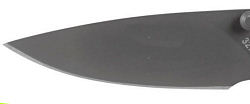 |
DROP POINT
Drop point is a knife blade that slopes on the spine of
the blade from the handle of the knife to the tip of the
blade, where the tip is still noticeably higher than the
midpoint of the blade, unlike a spear point where the tip is
at the midpoint. This allows the spine of the blade (where
the blade is thicker, and thus stronger) to continue forward
to the tip of the blade. The curve on the top of a
drop-point blade is always convex, which is what
distinguishes it from a clip point blade. The drop point is
typically thicker (especially at the tip) than a clip point.
This makes it a more versatile tool for game-care/butchering
tasks like disjointing and prying. The drop point is a very
common design for hunting knives. |
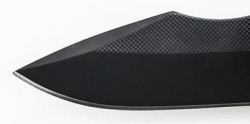
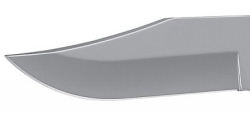 |
CLIP POINT
Clip point blades have the appearance of having the
forward third of the blade "clipped" off. The clip itself
can be straight or concave.
The blade spine then tapers in thickness in either a
straight line or a recurve to the knife's point, which may
be located above, below, or in line with the central axis of
the blade. Because the tip is controllable, sharp and
thinner at the spine, a
clip point knife lends itself to quicker stabbing
with less drag during insertion and faster withdrawal.The
thinned false edge of the clip may be sharpened to form a
true second cutting edge. If the false edge is sharpened it
increases the knife's effectiveness in piercing.
However, the tip of the clip point is not as strong as
that of the drop point and much more easily damaged. Take
good care of it and don't use the tip for prying
purposes! |
 |
TRAILING POINT
A trailing point knife is a lightweight knife that has a
back edge that curves upward. The "trailing point" is named
for the point which trails higher than the generalized axis
of the spine of the knife blade. These blades provide a
large curved cutting area (known as the "belly") and are
optimized for slicing or skinning. They offer the sharpest
point for fine, delicate, and small work, such as skinning
and caping game or fish. The blade is drawn toward the knife
user in a sweeping motion, cleanly separating the skin from
the game or fish. They are most commonly found on skinning
and filleting knives. |
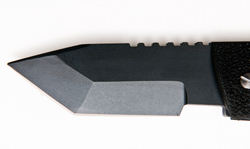
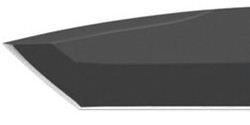 |
TANTO POINT
Tanto blades were invented by Cold Steel during the
late1970s, inspired by a classical Japanese design
with a "barracuda tip". Strength is a prominent feature of
tanto blades. Every tanto knife maintains a high point,
along with a flat grind. This structuring enables a very
powerful knife, which can puncture very hard materials. The
reinforced blade allows continuous puncturing without issues
such as the blade snapping or wearing down quickly if used a
lot. They're good for scraping, chiselling and prying ...
but that's about it.The lower photo is a modified tanto,
where the end is clipped and often sharpened. This brings
the tip closer to the centre of the blade increasing control
of the blade and improves penetration potential by having a
finer point and a sharpened back edge. |
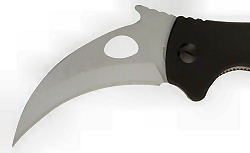 |
HAWKBILL
A knife blade with a concave cutting edge and claw-like
shape. This blade type is designed primarily to cut using a
pulling or raking motion and has both utilitarian and
martial applications. Utility-oriented knives of this type
are used to make long, continuous cuts in surfaces, with the
idea to reduce the wasted effort of simultaneously pressing
the blade into the item as one would with a straight blade.
They are also used by hooking thin items, such as plant
stems holding fruit, allowing the task to be done with only
the blade and no stabilizing hand, much like a sickle. The
most common example is the Southeast Asian karambit.
Push-cuts and slicing are difficult as the blade shape gets
in the way, so the only real use for a hawksbill blade is a
draw-cut. |
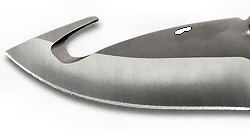 |
GUT HOOK
The gut hook is more of a blade feature than it is an
actual blade shape. Most gut hook knives are actually
trailing point skinners with the gut hook feature added to
the back spine. It's actually a unique type of blade with a
sharp hook to the top side of the blade near the tip. This
feature is designed for skinning animals: the hook is
inserted into a small nick made in the the skin of the
underside of the animal and is pulled like a zipper for the
initial cut. It is designed to cut into the animal skin
without slicing into any of the muscles or internal organs.Couple
of disadvantages: the back spine of the knife cannot be
sharpened, leaving only a singled edged front blade and
sharpening of the gut hook is relatively difficult unless
you have a round file with you. Also, the gut hook can be
dangerous if you're using the knife as a general utility
blade: it can hook up on clothing or even you. You won't use
it very often, so if you believe you need one it's best to
have a dedicated gut hook knife in ADDITION to your
main knife.
|
Choosing a Survival Knife
| Knife Sharpening
| Knife Steel Properties
| Knives and UK Law
| Knife Terminology
|
